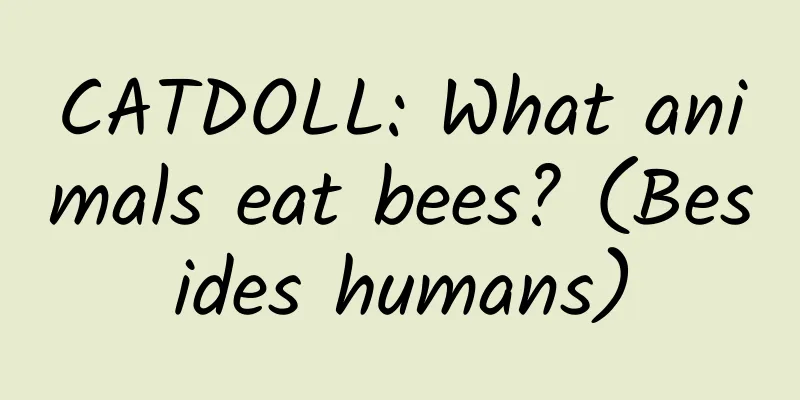CATDOLL : CATDOLL: What animals eat bees? (Besides humans)

|
There are many natural enemies of bees. They mainly include: birds (swallows, tits, etc.), spiders, ants, robber flies, hawk moths, bee eaters, honey hawks, honeycomb moths, bee lice, mantises, geckos, chameleons, dragonflies, bees' own kind (mud wasps, wasps, hornets, wasps, Italian bees, etc.), bears, etc. Let's introduce them in detail below. 1. Birds: Many small birds eat insects. Of course, they also eat bees. Woodpeckers use their powerful beaks to peck through beehives and eat the bees that have hibernated. 2 Honey Buzzards; because of their dense feathers, they are not afraid of being stung. They destroy beehives and eat bee eggs and larvae. 3. Dragonflies: They are terrible carnivorous insects that also eat bees as delicacies 4 Spiders: Spiders set up webs to catch bees, and crab spiders set traps in corollas to catch bees. 5. Honeycomb moth: A butterfly called the honeycomb moth lays its eggs in a beehive, and its caterpillars use the cells of vulnerable bee colonies to build webs. 6 Bee lice: A dipteran insect nicknamed "bee lice" parasitizes bees, especially queen bees, and forces its victims to spit out food. 7 Bears: When bears destroy beehives to eat honey, they also eat bee larvae. 8 Ants: Ants often crawl around beehives, enter beehives through cracks or nest doors, eat honey and pollen, attack bees, and interfere with the normal activities of bees. 9 Robber flies: Also known as fly dogs, they are yellow to black with white spots and 30 mm long. Robber flies are widely distributed in fields or wilderness, and often stay near bee farms, waiting for an opportunity to catch bees. When they catch up with bees, they pounce on them, hug them, and pierce their mouthparts into the membrane between the bees' necks to suck blood and lymph, killing the bees. 10 Hawk moth: Adults hide in the dark during the day and fly out at night to look for nectar or honey for food. Once they smell the scent of honey in the bee colony, they sneak into the beehive through the nest door to steal the honey. When the nest door is too small to enter, they use the abdominal segments to rub around the beehive to make sounds, so as to alarm the bee colony or disturb the bee colony in the gap outside the beehive. Hawk moth has little effect on Western honey bees. Once the hawk moth sneaks into the Chinese bee colony, it will cause the Chinese bees to abandon the nest and flee. 11 Bee-eaters: They are agile and good at hunting in flight. However, their food varies depending on the location and season. In addition to bees, they also prey on insects such as weevils, elm moths, horseflies, dragonflies, termites, and butterflies. 12 Praying mantis: It catches bees and other insects between flowers or branches. It moves quickly. 13 Geckos: When insects such as bees land near them, they will eat them quickly. 14 Chameleon: Ambush on branches and leaves. Use its long tongue to catch bees and other insects. (Same species as bees: There are many of this type, such as wasps, hornets, wasps, mud wasps, etc.) 15 Mud wasps: They look like giant wasps. After catching a bee, they squeeze its abdomen to extract all the nectar, and then leave the remains of the bee as food for their larvae. 16. Bumblebee: Large in size. Strong sense of territory. Often attacks bee nests. 17 Wasp: Like the bumblebee, it often attacks bees. 18 Wasp: Wasps are larger than bees and are similar to wasps. They often attack bees. 19 Italian bees: The most noteworthy Italian bees are invasive alien species. They are native to Italy. This type of bee specializes in killing Chinese bees and other Chinese bees. Because the vibration frequency of the wings of Italian bees is similar to that of Chinese bees, the worker bees of Chinese bees will think that they are of the same kind. When Italian bees enter the nest, they will directly kill the queen bee, resulting in the extinction of the entire nest of bees. Other animals only eat or kill a few bees, while Italian bees kill one nest after another at an alarming speed. Bees in many areas are facing the threat of Italian bees. Some bee species have even disappeared. For example, the black bees in Inner Mongolia are facing a huge threat because of the introduction of Italian bees. Now a protection association has been established to protect black bees and prohibit Italian bees from entering. The above answers are quite complete. I hope they are helpful to you. Supplement: If you want to get close to bees, you should pay attention to safety. It is best to bring protective equipment. Or smoke the beehive first. Bees are afraid of smoke and run away. Then you can get close to the hive. The natural enemies of bees generally include ants, robber flies, hawk moths, etc. Ants often crawl around beehives, enter beehives through the gaps or nest doors, eat honey and pollen, attack bees, and interfere with the normal activities of bees. Its prevention and control methods: ① Destroy ant nests: After finding the ant nests, use wooden stakes or bamboo poles to make 3-4 holes about 60 cm deep, pour kerosene, and then fill them with soil; you can also dig up the ant nests, sprinkle quicklime, and then water or spray 5%-10% sodium sulfite solution for prevention and control. ② Raise the beehive: Drive a wooden stake at each of the four corners of the beehive, and apply asphalt or tung oil on the stakes to repel ants. ③ Ant mites control: This drug is particularly effective against ants and harmless to bees. When ants are found to be harming bees, spray 3-5 grams of mites on the ant trails and ant bodies, and let them return to the nest to poison and kill all the ants in the nest. Robber flies, also known as fly dogs, are yellow to black with white spots and 30 mm long. Robber flies are widely distributed in fields or wilderness, and often stay near bee farms, waiting for an opportunity to catch bees. When they catch up with a bee, they pounce on it, hug it, and pierce its mouthparts into the membrane between the bee's neck to suck hemolymph and kill it. To prevent and control robber flies, you can use manual beating methods. Adult hawk moths hide in dark places during the day and fly out at night to look for nectar or honey for food. Once they smell the scent of honey in the bee colony, they sneak into the beehive through the nest door to steal the honey. When the nest door is too small to enter, they use the segments of their abdomen to rub and make sounds around the beehive to alarm the bee colony or disturb the bee colony in the gaps outside the beehive. Hawk moths have little effect on western honey bees. Once hawk moths sneak into the Chinese bee colony, it will cause the Chinese bees to abandon the nest and flee. The prevention and control method is to add 1000 times solution of 3% crystal dichlorvos to syrup and pour it into a sponge carrier, place it around the apiary at night, and collect it in the early morning of the next day; you can also put honey and wine in a container, and then cover it with an iron gauze cage with a funnel-shaped opening on it, so that when the hawk moth enters the cage to eat the honey wine, it will drown. In addition, a Chinese ramie leaf beetle appeared in Ningxia in the autumn of 2004. This beetle belongs to the beetle family and is a pest of bees. Its large-scale appearance and reproduction will cause a large number of deaths in the bee colony. Some queen bees are stung to death, and some are eaten. Japanese Hornet Bees are a delicacy for many natural enemies, but no natural enemy can destroy the entire colony of bees by eating a few bees. The natural enemies of bees are insectivorous birds such as swallows, bee-eaters, and tits. If the winter is very cold, the green woodpecker will use its powerful beak to peck through the beehive and eat the bees that have been closed for the winter. Honey buzzards, which are birds of prey, are not afraid of stings because of their dense feathers. They destroy beehives and eat bee eggs and larvae. Some insects are also bee killers. They sting and kill bees. Mud wasps are one of them. They look like large wasps. After catching a bee, they squeeze its abdomen to extract all the nectar, and then leave the bee's remains as food for their larvae. Dragonflies are terrible carnivorous insects, and they also regard bees as delicacies. Spiders set webs to catch bees, crab spiders set traps in the corolla to catch bees, and orb-web spiders "wait for bees in their webs." Other animals are interested in the fruits of bees' labor, such as beehives and honey. Wasps covet the honey stored in beehives, a butterfly called the beehive moth lays its eggs in the beehive, and caterpillars use the cells of vulnerable bee colonies to weave webs. A dipteran insect nicknamed "bee louse" parasitizes bees, especially queen bees, and forces victims to spit out food. The most terrifying is bee spore disease caused by a single-cell organism, and aspergillosis caused by fungi, which can paralyze the respiratory system of bees and cause blindness. Among mammals, bears are honey gourmets. The natural enemies of bees are insectivorous birds such as swallows, bee-eaters, and tits. If the winter is very cold, the green woodpecker will use its powerful beak to peck through the beehive and eat the bees that have been shut in for the winter. Honey buzzards, which are birds of prey, are not afraid of being stung because of their dense feathers. They destroy beehives and eat bee eggs and larvae. Some insects are also bee killers. They sting and kill bees. Mud wasps are one of them. They look like large wasps. After catching a bee, they squeeze its abdomen to extract all the nectar, and then leave the bee's remains as food for their larvae. Dragonflies are terrible carnivorous insects that also regard bees as delicacies. Spiders set webs to catch bees, crab spiders set traps in the corolla to catch bees, and orb-web spiders "wait for the bees in their webs." Other animals are interested in the fruits of bees' labor, such as beehives and honey. Wasps covet the honey stored in beehives, a butterfly called the beehive moth lays its eggs in the beehive, and caterpillars use the cells of vulnerable bee colonies to weave webs. A dipteran insect nicknamed "bee louse" parasitizes bees, especially queen bees, and forces victims to spit out food. The most terrifying is bee spore disease caused by a single-cell organism, and aspergillosis caused by fungi, which can paralyze the respiratory system of bees and cause blindness. Among mammals, bears are honey gourmets. Wasps, ants, dragonflies, spiders and some birds, viruses. The most common ones that affect bees are the ones listed above during the day, and cockroaches, wax moths, etc. at night. Especially wax moths (a kind of moth), which are nothing in themselves, but the larvae produced by their eggs in the hive will cause the bee colony to abandon the nest and move. Stings, ants, hornets, wasps, spiders, greedy humans And the Beehive! |
<<: CATDOLL: Why do pig-nosed turtles grow so slowly?
>>: CATDOLL: How to feed sugar water to beekeepers in lattice boxes?
Recommend
CATDOLL: Revealing the truth about the scam of earthworm farming (how much profit can be made from 5 mu of earthworm farming in a year)
1. Is it okay to catch earthworms and recycle the...
CATDOLL: Where is the best place to keep snails at home?
1. It likes dark, moist and secluded environment,...
CATDOLL: Where is the best place to keep spiders?
Where is the best place to keep spiders? Spiders ...
CATDOLL: How to pair and appreciate racing pigeons
It is said that eyes are windows to the soul. The...
CATDOLL: Why do pig's trotters easily become swollen?
Causes of swollen pig's trotters Pig's tr...
CATDOLL: The correct way to use pig lung
Introduction of pig lung Pork lung is a common in...
CATDOLL: How to deal with and treat chicken inflammation in summer
Causes of chicken inflammation in summer In the s...
CATDOLL: If the big yellow eel dies, can the newly born baby yellow eels survive?
1. If the big yellow eel dies, can the newly born...
CATDOLL: How many days does it take to raise silkworms?
1. How long does it take for a silkworm to grow? ...
CATDOLL: What is the price of earthworms?
Price of earthworms? In 2014, the market price of...
CATDOLL: How to pronounce the words "盐" and "羊" correctly
In Chinese characters, some characters seem simpl...
CATDOLL: How to deal with the live red worms you bought when you get home (How to deal with the live red worms you bought when you get home)
1. How to clean the dead red worms after buying t...
CATDOLL: How to farm freshwater grouper? What is the market prospect?
Freshwater grouper farming requires maintaining a...
CATDOLL: How long does it take to sell the earthworms after breeding? (How long does it take to sell the earthworms after breeding?)
1. How long does it take to harvest the finished ...
CATDOLL: How to buy the freshest oysters and what should you pay attention to when choosing oysters?
How to choose fresh and plump oysters? Oysters ar...









